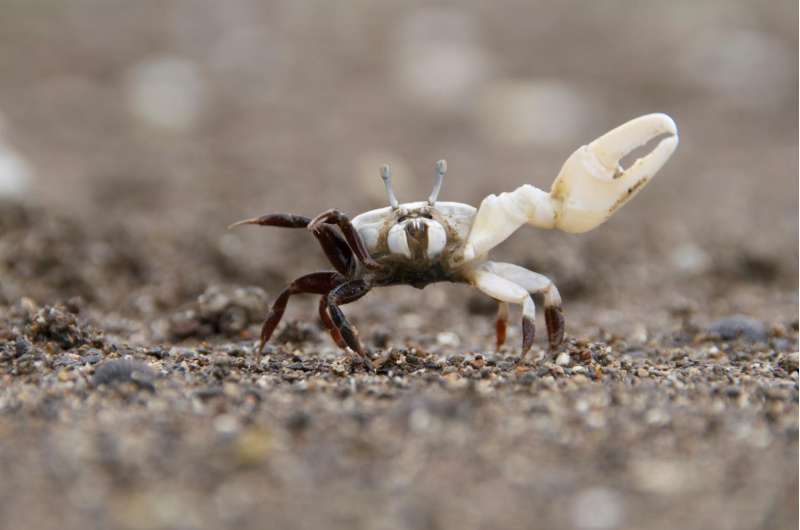Male fiddler crabs produce female-luring vibrations in their burrows

The vibrations and pulses that male fiddler crabs produce when they are trying to lure females into their burrows to mate are surprisingly informative. These signals serve as a type of "Morse code" that the females decipher to learn more about the size and stamina of their suitors. This is according to a study by Japanese researchers Fumio Takeshita of Nagasaki University and Minoru Murai of the University of the Ryukyu, published in Springer's journal The Science of Nature.
During mating season, the males of some fiddler crab species construct a raised mound or semidome near their burrows. They stay close to their burrows and wave their one distinctively large claw to attract females to their burrow's entrance. The ones able to wave their claws higher and for a longer period of time have the most success. Once a female comes closer, the male repeatedly emits vibrations to lure her even further inside his hide-out, with the intention to eventually mate.
Takeshita and Murai went to the tidal flat of Nagaura Island in Kumamoto in Japan to investigate how these vibrations might be helping female fiddler crabs (Uca lactea) to decide on a preferred mate. The researchers used a female dummy to elicit courtship vibrations from several males. These were recorded and analysed further.
The researchers learned that these acoustic signals consist of repetitive pulses. The lower the dominant frequency, the more likely it was that the male's body or carapace would be quite large. The length of the pulses decreased slightly when more vibrations were repeatedly produced. The interval between such pulses also increased when more pulses were produced.
"These factors imply that the vibrations convey information on male characteristics, such as body size and stamina," says Takeshita.
The production of vibrations and the initial waving of one large claw in the air therefore seem to go hand in hand. Both are ways by which males can signal their endurance and stamina to potential mates.
Observing fiddler crabs mating with real females, the researchers also looked at what happened once the females were successfully lured to a burrow entrance. Females were more likely to enter the burrow of males that could repeatedly produce a higher rate of pulses in succession. "This indicates that the females use the male vibrational signals to decide whether to enter the burrow or not," adds Murai.
The researchers found that once a female finds herself inside a burrow, the continuous production of vibrations plays no further role in her decision to mate. Aspects such as the protective structure of the burrow, in which she will possibly release larvae, might therefore also come into play.
More information: Fumio Takeshita et al, The vibrational signals that male fiddler crabs (Uca lactea) use to attract females into their burrows, The Science of Nature (2016). DOI: 10.1007/s00114-016-1371-2
Provided by Springer



















